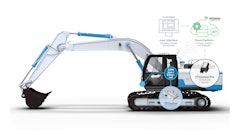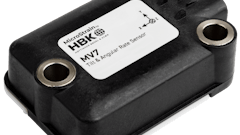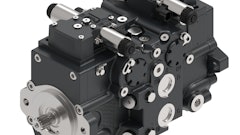"How big is it, and how do we get it from here to there?" was the question asked by the personnel of the Wideband Global SATCOM (WGS) Program Office at Los Angeles AFB, CA. "It" is the Boeing Next Generation Transporter, which will be used to transport WGS satellites from the factory in El Segundo, CA, to the launch site at Cape Canaveral Air Force Station in Florida. The Air Force uses WGS satellites for global positioning system (GPS) services and other communication needs.
The satellites are put in a transporter and loaded on a C-5A/B aircraft. Boeing produced a transporter capable of holding one satellite which by itself weighs up to 16,000 lbs; however, the Aeronautical Systems Center, Air Transportability Test Load Agency (ASC/ATTLA), required a loading demonstration prior to issuing an air transportability certificate. Earlier this year, the Air Mobility Command Test and Evaluation Squadron (AMCTES) received the test order to conduct an Air Transportability Test Load of the Boeing Next Generation Transporter.
Located at McGuire AFB NJ, AMCTES provides AMC with centralized expertise for enhancing air mobility. The largest part of its mission is to ensure new systems and equipment meet AMC operational needs through Force Development Evaluations (FDE), Operational Utility Evaluations (OUE), and Operational Assessments (OA). Additionally, AMCTES evaluates new tactics and procedures. Experts from across the spectrum of Air Force operational backgrounds (e.g., aircrew, maintenance, transportation, communications, aeromedical, and electronic warfare personnel) take the lead as test directors in the final stages of operational advances in AMC. Loadmaster experts from the Operations Flight took the test order and planned, coordinated, and conducted a command-level operational test load of the Boeing Next Generation Transporter.
AMCTES chose MSgt Larry A. Hall as the lead test director for the Boeing Next Generation Transporter. MSgt Hall was responsible for all aspects of the test, from planning and writing the test plan to execution to reporting results and conclusions in a final report. He devised a strategy to collect data in the most cost-efficient and effective way, working hand-in-hand with the HQ AMC Test and Evaluation (TE) test manager to obtain required support for the project.
Tight fit
The transporter is self-propelled with a steerable wheel system and a fully mechanized tilting capability to load and transport spacecraft. Using a semi-tractor, the Boeing Next Generation Transporter is towed to the contractor-provided loading ramps and disconnected from the tractor for aircraft loading. The C-5 is then positioned in the level kneel, truck loading configuration and the transporter's electric motor (with a back-up, self-contained diesel engine) is used to drive the transporter up the forward loading ramps and into the C-5.
Maximum transporter weight is 80,000 lbs. when loaded with a 16,000-lb. spacecraft. The transporter measures 64 ft. 11 in. long, 189 in. wide, and 160 in. high when configured for C-5 loading. The transporter's height allowed for only 2.5 in. of clearance between the top of the transporter and the aircraft cargo compartment ceiling, and only 1.0 in. between the transporter and the cargo compartment floor.
Once identified as the lead test director, MSgt Hall's responsibilities began with gathering information and thoroughly reviewing any relevant research on previous testing of this transporter or any similar equipment. He immediately sought out the help of MSgt Anthony Marose, loadmaster with the 22d Airlift Squadron, Travis AFB CA, as a C-5 subject matter expert. Together they researched C-5 loading capabilities and planned the strategy and resources required to safely conduct the test. Once the test concept was given a rigorous review, MSgt Hall met with Test and Evaluation Squadron leadership to identify potential problems and resolve any "up-front" issues that might exist.
The test took place using a C-5B aircraft at Travis AFB to onload, secure, and offload the transporter. The 60th Air Mobility Wing provided two C-5 maintenance personnel, five C-5 loadmasters, two qualified Joint Inspectors, and a four-person aerial port crew. The day prior to the test, information required for cargo validation of the transporter, ramps, and generator were collected by Joint Inspectors from the 60th Aerial Port Sq (APS).
An important decision to ensure certification was to determine the actual number of personnel required to safely load the transporter on the aircraft. The test team determined that four loadmasters, a four-person aerial port crew, and six Boeing representatives were needed to load the transporter. The first and second loadmasters were positioned at the top of each end of the transporter to observe the clearance between the transporter and the ceiling of the cargo compartment. The third loadmaster was positioned inside the aircraft and the fourth loadmaster was positioned outside the aircraft. The third and fourth loadmasters worked closely with the Boeing representatives who operated the controls used to drive the transporter into the aircraft.
The clearance between the transporter and the ceiling of the cargo compartment, and the clearance between the bottom of the transporter and the cargo compartment floor were continuously monitored by all four loadmasters. Critical clearances were continuously monitored. The C-5B was positioned to allow 250 feet of space forward of the aircraft for transporter maneuvering. Initially, the aircraft was configured in the forward kneel position. However, the measurement of 160 in. from the top surface of the ramp to the flight deck ceiling was not large enough to load the transporter. So, the C-5 was reconfigured to a level-kneel, truck-loading position. The cargo doors were opened and the ramp was lowered to the ground. The Boeing auxiliary ramps were positioned and leveled with the aircraft ramps. To ensure clearance, and provide an extra 2.25 in., the fire detection optical sensor located on the cargo compartment ceiling at the forward opening had to be removed.
The transporter's electric motor was used to drive the transporter, drive-axle first, up the forward loading ramps and into the C-5B. An external generator was used as the power source for the transporter's electric motor and a 100-ft. power cable was used to plug the transporter into the generator outside the aircraft. With this engine, the loadmaster could control the speed of the transporter, the steering and braking, and could also lower and raise the transporter to ensure clearance. When the transporter was in the final position in the aircraft, it was lowered onto plywood sheets, the wheels were raised off the floor, and it was secured with tie-down chains. The ramps and generator were loaded using a forklift.
Offloading was essentially the reverse of the onloading procedure except the transporter's self-contained diesel engine was tested to drive the transporter down the forward loading ramps and off the C-5B.
This part of the test revealed that the diesel engine was loud and interfered with the communication between the Boeing employees and the loadmasters. In addition, the exhaust port directly adjacent to the second loadmaster's position created exhaust fumes to strong for this loadmaster to remain in position. The test team recommended redesigning the transporter's diesel engine exhaust away from this position to prevent excessive exhaust fumes from interfering with the loadmaster's ability to observe critical ceiling clearances. In addition, the team recommended using the electric motor for all primary operations and using the diesel engine only if the electric motor fails.
The transporter was successfully loaded; however, the test team concluded that several factors could influence the ability to load the transporter safely every time: the slope and surface condition of the aircraft parking location, the weight of the satellite, the amount of fuel in the aircraft, and wind gusts that might move or twist the airframe, reducing clearances that are already extremely critical.
Watching the C-5B consume the transporter was, as stated by a member of the test team, "like watching a boa constrictor swallow its prey whole."


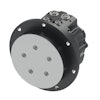
![Hcm Ax Landcros Press Release[32] jpg](https://img.oemoffhighway.com/mindful/acbm/workspaces/default/uploads/2025/11/hcmaxlandcros-press-release32jpg.mAEgsolr89.jpg?auto=format%2Ccompress&fit=crop&h=100&q=70&w=100)

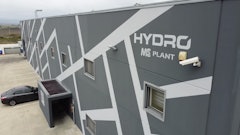

![Hcm Ax Landcros Press Release[32] jpg](https://img.oemoffhighway.com/mindful/acbm/workspaces/default/uploads/2025/11/hcmaxlandcros-press-release32jpg.mAEgsolr89.jpg?ar=16%3A9&auto=format%2Ccompress&fit=crop&h=135&q=70&w=240)




